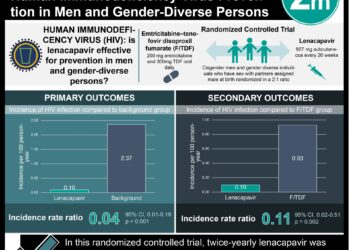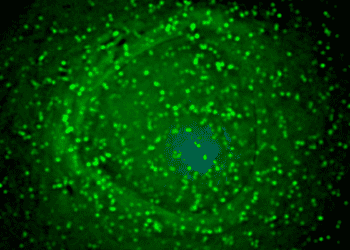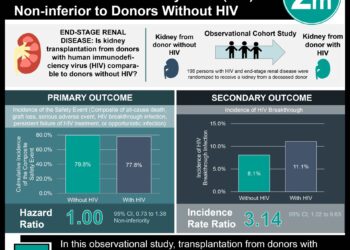Shifting causes of death in HIV patients from 1999-2011 [D:A:D study]
1. The rate of death among HIV-positive individuals treated with antiretroviral therapy decreased from 1999-2011. The leading causes of death were due to AIDS-related causes, non-AIDS-defining cancers, liver disease, and cardiovascular disease.
2. The percentage of all deaths due to AIDS-related causes, cardiovascular disease, and liver disease decreased from 1999-2000 to 2009-2011, while deaths due to non-AIDS-related cancers increased in the same time period.
Evidence Rating Level: 2 (Good)
Study Rundown: The development of antiretroviral therapy (ART) in the treatment of HIV has led to a decrease in AIDS-related mortality in the HIV-positive population, with life expectancy nearing that of the general population. However, non-AIDS related comorbidities may be higher in HIV patients due to higher levels of traditional risk factors such as smoking and hepatitis co-infection, chronic inflammation associated with HIV infection, and ART-related adverse effects such as dyslipidemia and diabetes. The Data collection on Adverse events of anti-HIV Drugs (D:A:D) study followed HIV-positive participants receiving care in Europe, USA, and Australia from 1999 to 2011 to identify trends in all-cause mortality and mortality due to specific organ systems or cancers.
Leading causes of death were AIDS-related, followed by non-AIDS-defining cancers, liver disease, and cardiovascular disease. The percentage of all deaths due to AIDS-related causes decreased from 1999-2000 to 2009-11 but remained the most common cause of death. Deaths due to cardiovascular disease and liver disease also decreased while non-AIDS-related cancer deaths increased during the same time period. Limitations of this study include the exclusion of HIV-infected individuals not treated regularly or unaware of their infection status as well as non-HIV-infected controls. The authors suggest that improvements in mortality over time can be explained by the benefit of antiretroviral therapy and changes in CD4 cell count but the relative increase in non-AIDS-related cancer deaths warrant further investigation.
This study was funded by the Oversight Committee for the Evaluation of Metabolic Complications of HAART, with representatives from academia, patient community, US Food and Drug Administration, European Medicines Agency and consortium of AbbVie, Boehringer Ingelheim, Bristol-Myers Squibb, Gilead Sciences, ViiV Healthcare, Merck, Pfizer, F Hoffmann-La Roche, and Janssen Pharmaceuticals.
Click to read the study, published today in The Lancet
In-Depth [prospective cohort]: 49,731 HIV-positive individuals receiving care at 212 clinics in Europe, USA, and Australia were included in the study and recruited at three different intervals: 1999-2001, 2003-04, and 2010. Participants were followed from entry until 6 months after their last clinic visit, 2011, or death, whichever occurred first. 3,909 deaths occurred over 308,719 person-years of follow-up (median 5.8 person-years, Interquartile range [IQR] 3.3-9.9), corresponding to a crude incidence mortality rate of 12.7 per 1000 person-years (95% Confidence Interval [CI] 12.3-13.1).
A higher proportion of deaths occurred in participants that were men, hepatitis C positive, IV drug users, smokers, previously diagnosed with AIDS, and had a lower median CD4 count at study entry than the rest of the study population. Leading causes of death were AIDS-related (1123 [29%] deaths), non-AIDS-defining cancers (590 [15%] deaths), liver disease (515 [13%] deaths), and cardiovascular disease (436 [11%] deaths). The percentage of all deaths due to AIDS (87/256 [34%] in 1999-2000 vs. 141/627 [22%] in 2009-11; p<0.0001) and liver disease (40/256 [16%] vs. 64/627 [10%]) decreased, while non-AIDS-related cancers increased (24/256 [9%] vs. 142/627 [23%]). Rates of all-cause death per 1000 person-years decreased from 17.5 in 1999-2000 to 9.1 in 2009-11, as well as AIDS-related (5.9 to 2.0), liver disease (2.7 to 0.9), and cardiovascular disease deaths (1.8 to 0.9). However, non-AIDS-related cancers increased slightly (1.6 to 2.1, p=0.58). After adjusting for factors that changed over time, including CD4 cell count, there was no decrease in AIDS-related death rates (relative rate for 2009-11 vs. 1999-2000: 0.92 [95% CI 0.70-1.22]). However, all-cause (0.72 [0.61-0.83]), liver disease (0.48 [0.32-0.74]), and cardiovascular disease (0.33 [0.20-0.53]) death rates did decrease over time.
Image: PD
More from this author: New dengue fever vaccine effective in phase 3 trial, Insulin pumps more effective than multiple daily injections in type II diabetics [OpT2mise trial], Heart attack hospitalization rate in China quadruples from 2001-2011, Vitamin D supplementation does not reduce risk of falls, ¹⁸F-FDG PET brain imaging could predict recovery in vegetative patients
©2012-2014 2minutemedicine.com. All rights reserved. No works may be reproduced without expressed written consent from 2minutemedicine.com. Disclaimer: We present factual information directly from peer reviewed medical journals. No post should be construed as medical advice and is not intended as such by the authors, editors, staff or by 2minutemedicine.com. PLEASE SEE A HEALTHCARE PROVIDER IN YOUR AREA IF YOU SEEK MEDICAL ADVICE OF ANY SORT.







